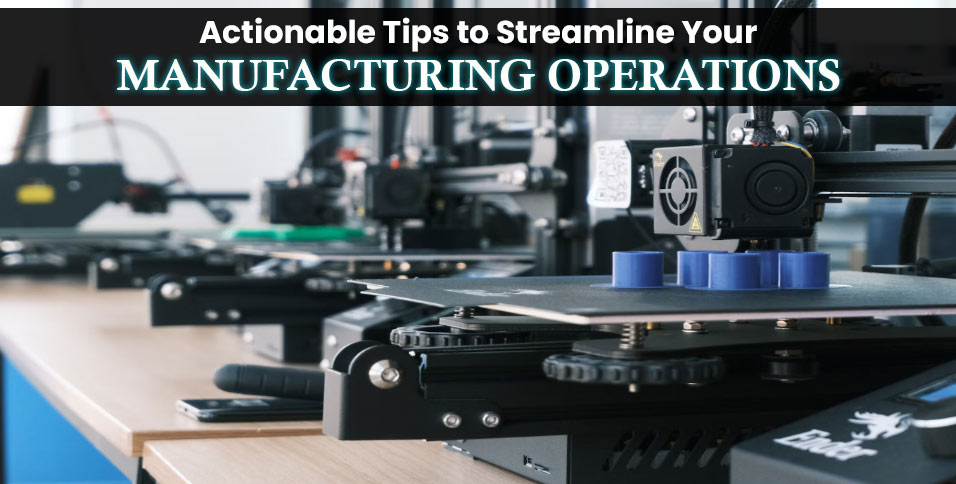Despite the challenges and slowdown caused by the pandemic, the American manufacturing industry is growing. According to data from the Conference Board, the country ranks ninth out of 142 in terms of output per hour. Manufacturers contribute 10.70% of overall output, contributing a staggering $2.5 trillion by 2021. The sector also employs 8.4% of the American labor force.
While these numbers look great, the American manufacturing sector is currently witnessing a decline in its share of output and labor productivity. As a manufacturer, you have a reason to worry because even the best efforts may not yield the desired results. Besides elevating production costs, the efficiency gaps can affect your competitive advantage.
In this article, we will share a few actionable tips to help you overcome efficiency barriers and streamline your manufacturing operations.
Adopt Lean Manufacturing Principles
Lean manufacturing methodologies can help you eliminate waste and maximize value. According to Industry Week, the lean approach can increase productivity and drive a sustained reversal in manufacturing outflow. It continuously reduces bottlenecks and improves customer value through data-driven tools and employee engagement.
To go lean, you must begin with a thorough assessment of your current processes to determine the areas for improvement. Tools like value stream mapping can help you visualize workflows and optimize production lines. Also, encourage employees to contribute to continuous improvement efforts and create a culture of efficiency.
Win with Innovative Manufacturing Technologies
Innovative technology, such as robotics, automation, and Internet of Things (IoT) devices, can help factories increase production and quality. For example, robotic process automation can do repetitive activities with precision, reducing the requirement for manual labor. IoT sensors enable predictive maintenance and save downtime by providing real-time information on equipment performance.
Additive manufacturing technologies, such as 3D printing, can accelerate prototype development and reduce time to market. Similarly, computer numerical control (CNC) machining allows for the precise and efficient production of intricate parts. According to Jiga.io, adopting these technologies is easy as you can source custom parts by collaborating directly with vetted manufacturers.
Direct partnership through an online platform ensures open communication with providers, enabling businesses to procure machines and parts on time. Besides on-time procurement, this collaboration model guarantees quality parts and minimal friction.
That said, even traditional equipment is changing with the times. In addition to integrating technological solutions, it’s just as important to find a reliable manufacturer for handheld tools like industrial glue guns that use the latest innovations to increase the quality of the final product.
Optimize Supply Chain Management
The pandemic led to significant supply chain disruptions around the world, driving manufacturing enterprises to the brink. The difficulty persisted in 2023, with variables such as labor shortages, low retention, out-of-stock needs, and consumer demands for customization hurting supply chains. Businesses looking to streamline operations must strengthen their supply chains.
Robust supply chains hinge on strong relationships with suppliers and optimized sourcing strategies. Besides working on these objectives, consider utilizing just-in-time inventory management to reduce carrying costs and excess inventory. You can also use data analytics to forecast demand and mitigate supply chain risks
Invest in Employee Training and Development
Manufacturing efficiency greatly relies on the labor force as a productive workforce contributes to product quality and overall profitability. Skilled and trained workers also reduce wastage and create a safe workplace for a thriving business. Invest in comprehensive training programs to assist employees in developing the knowledge and skills they need to give their best to their jobs.
Organize workshops, seminars, and online courses to promote lifelong learning. You can go the extra mile by providing cross-training opportunities to boost flexibility and create cross-departmental collaboration. Remember to recognize and reward top performers because it drives them to work harder to increase operational efficiency.
Prioritize Sustainability
Manufacturing leaves a high carbon footprint owing to energy usage and emissions. According to the National Institute of Standards and Technology, the manufacturing sector is directly responsible for 17% of the 76.6% of emissions produced by the US industrial industry. Fortunately, manufacturers recognize the financial and environmental benefits of sustainable business practices.
You may optimize your production processes by optimizing resource usage and lowering environmental impact. For example, eco-friendly materials and recycling activities contribute to waste reduction and circularity throughout the manufacturing process. Investing in renewable energy and switching to LED lighting can assist in cutting carbon emissions and operating costs.
Prioritizing sustainability can also help manufacturers get government credits and incentives. It also boosts business reputation and attracts an increasing number of environmentally conscious customers.
As a manufacturer, you don’t have to spend a fortune to improve your industrial operations. These easy and effective actions can completely transform your process, preparing it for efficiency, cost savings, and sustainability. They also help businesses stay a step ahead of competitors in today’s fast-paced industry.
Also Read: Streamline Your Supply Chain With MRP Systems: Key Benefits Explained














